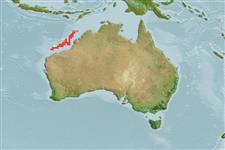>
Perciformes/Scorpaenoidei (Scorpionfishes) >
Neosebastidae (Gurnard scorpionfishes)
Etymology: Neosebastes: Greek, neos = new + Greek, sebastes = august, venerable (Ref. 45335); longirostris: Name after the Latin word 'longus' meaning long and 'rostrum' meaning snout, referring to the long snout..
Environment: milieu / climate zone / depth range / distribution range
Écologie
marin démersal; profondeur 170 - 250 m (Ref. 54394). Tropical; 14°S - 20°S (Ref. 54394)
Eastern Indian Ocean: Off northwestern coast of Western Australia.
Taille / Poids / Âge
Maturity: Lm ? range ? - ? cm
Max length : 16.9 cm SL mâle / non sexé; (Ref. 54394)
Description synthétique
Morphologie | Morphométrie
Épines dorsales (Total): 8; Rayons mous dorsaux (Total): 8; Épines anales 3; Rayons mous anaux: 5. Diagnosis: Underside of mandible with numerous tiny pores, no ridges. Preocular spine usually simple, and flattened anteriorly and posteriorly; supraocular spines occurring only posterior to vertical midline of eye; no additional spines between lacrimal and suborbital ridges; upper opercular spine simple. Midinterorbital space covered with scales; interorbital space shallow, becoming shallower with growth. Pored lateral-line scales 34-36 (mode 35); longitudinal scale rows 57-63 (57). Pectoral-fin rays 20-22 (21); pectoral fin short (2.9-3.5, mean 3.2 in SL), not reaching a vertical at origin of last dorsal-fin spine. Posterior margin of maxilla not reaching a vertical at posterior margin of pupil. Snout length long (3.5-4.0, 3.7 in HL); interorbital width wide (5.2-6.7, 5.7 in HL); body depth shallow (2.8-3.4, 3.1 in SL). Bilobed portion of swimbladder less than half of total swimbladder length. There are no distinct small black spots on head or lateral line (Ref. 54394).
Found on the continental shelf and continental slope (Ref. 75154). Most specimens taken in trawls have sand grains inside the mouth indicating occurrence on open, predominantly sandy substrata (Ref. 54394).
Life cycle and mating behavior
Maturité | Reproduction | Frai | Œufs | Fécondité | Larves
Motomura, H., 2003. Revision of the scorpionfish genus Neosebastes (Scorpaeniformes: Neosebastidae), with descriptions of five new species. Indo-Pac. Fish. (37):46 p. (Ref. 54394)
Statut dans la liste rouge de l'IUCN (Ref. 130435)
Menace pour l'homme
Harmless
Utilisations par l'homme
Plus d'informations
PaysZones FAOÉcosystèmesOccurrencesIntroductionsStocksÉcologieRégime alimentaireÉléments du régime alimentaireConsommation alimentaireRation
Noms communsSynonymesMétabolismePrédateursÉcotoxicologieReproductionMaturitéFraiRassemblement de ponteFéconditéŒufsDéveloppement de l'œuf
Taille/ÂgeCroissanceLongueur-poidsLongueur-longueurFréquences de longueursMorphométrieMorphologieLarvesDynamique des populations larvairesRecrutementAbondanceBRUVS
RéférencesAquacultureProfil d'aquacultureSouchesGénétiqueElectrophoresesHéritabilitéPathologiesTraitementNutrientsMass conversion
CollaborateursImagesStamps, Coins Misc.SonsCiguateraVitesseType de nageSurface branchialeOtolithesCerveauxVision
Outils
Articles particuliers
Télécharger en XML
Sources Internet
Estimates based on models
Preferred temperature (Ref.
123201): 13.6 - 19, mean 16.5 °C (based on 11 cells).
Phylogenetic diversity index (Ref.
82804): PD
50 = 0.5002 [Uniqueness, from 0.5 = low to 2.0 = high].
Bayesian length-weight: a=0.01995 (0.00906 - 0.04395), b=3.01 (2.83 - 3.19), in cm total length, based on all LWR estimates for this body shape (Ref.
93245).
Niveau trophique (Ref.
69278): 3.6 ±0.5 se; based on size and trophs of closest relatives
Fishing Vulnerability (Ref.
59153): Low vulnerability (11 of 100).
